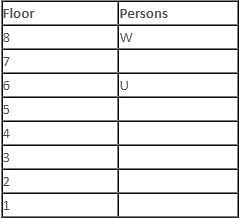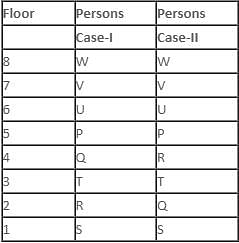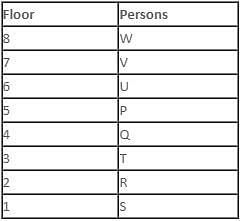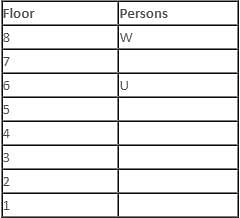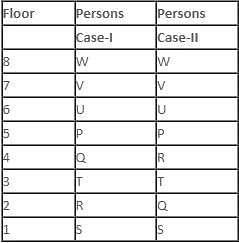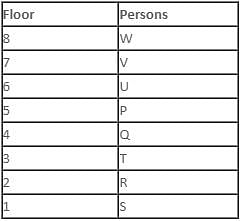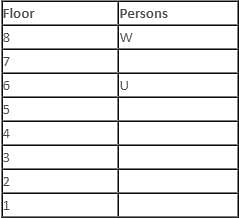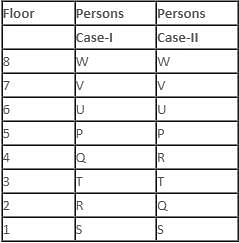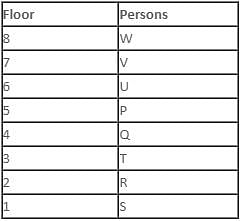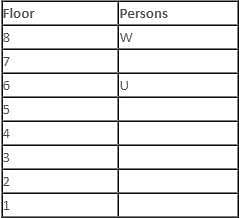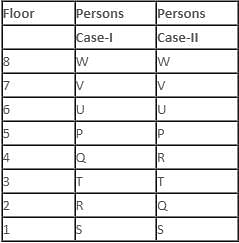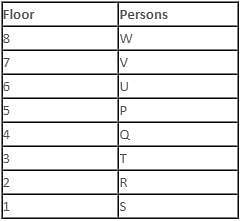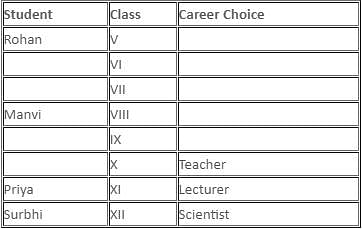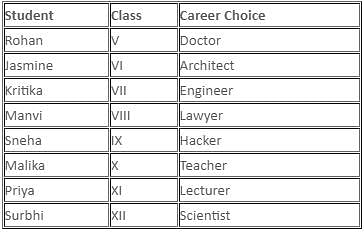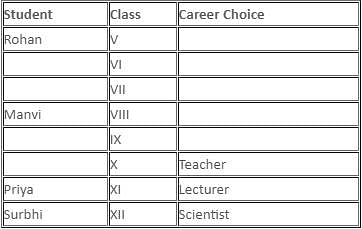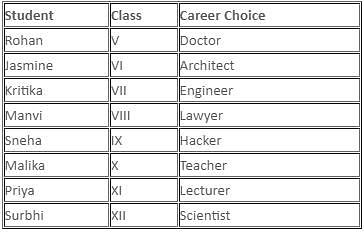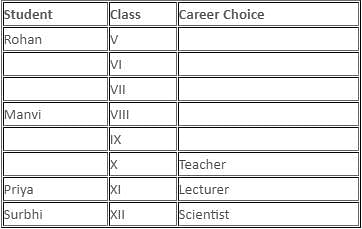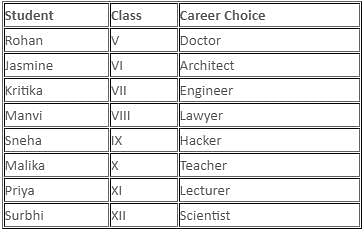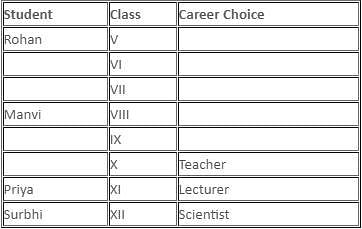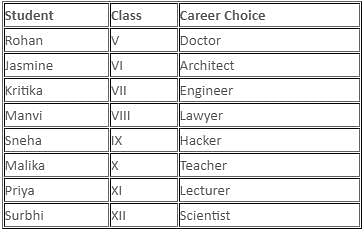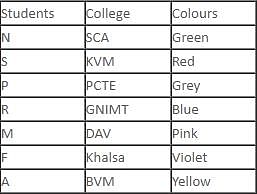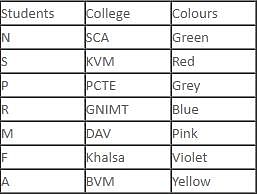CAT Practice Test: Week 18 - CAT MCQ
30 Questions MCQ Test Daily Test for CAT Preparation - CAT Practice Test: Week 18
If x = loga (bc), y = logb (ca) and z = logc (ab) when which of the following is equal to 1?
What is the value of x in the following expression: log2 ( 3 - x ) + log2 ( 1 - x ) = 3?
What is the value of x if log3x + log9x + log27x + log81x = 25/4?
What is the number of zeros coming immediately after the decimal point in the value of (0.2)25 ? (log102 = 0.30103)
Directions: Read the following information and answer the question given below.
A hotel has eight floors, numbered from 1 to 8, in such a way that the ground floor is numbered 1, the floor above the ground floor is numbered 2, and so on. The topmost floor is numbered 8.
P, Q, R, S, T, U, V and W are each staying on one of these floors. U is staying on floor 6. There are three floors between the floors on which P and S are staying. W is staying on the topmost floor. Neither S nor R is staying on floor 5. T is staying on the floor immediately above and immediately below the floors of Q and R, but not necessarily in the same order. R is not staying on the floor which is immediately above or immediately below the floor of P.
On which of the following numbered floors is Q staying?
Directions: Read the following information and answer the question given below.
A hotel has eight floors, numbered from 1 to 8, in such a way that the ground floor is numbered 1, the floor above the ground floor is numbered 2, and so on. The topmost floor is numbered 8.
P, Q, R, S, T, U, V and W are each staying on one of these floors. U is staying on floor 6. There are three floors between the floors on which P and S are staying. W is staying on the topmost floor. Neither S nor R is staying on floor 5. T is staying on the floor immediately above and immediately below the floors of Q and R, but not necessarily in the same order. R is not staying on the floor which is immediately above or immediately below the floor of P.
Who is staying on floor numbered 7?
Directions: Read the following information and answer the question given below.
A hotel has eight floors, numbered from 1 to 8, in such a way that the ground floor is numbered 1, the floor above the ground floor is numbered 2, and so on. The topmost floor is numbered 8.
P, Q, R, S, T, U, V and W are each staying on one of these floors. U is staying on floor 6. There are three floors between the floors on which P and S are staying. W is staying on the topmost floor. Neither S nor R is staying on floor 5. T is staying on the floor immediately above and immediately below the floors of Q and R, but not necessarily in the same order. R is not staying on the floor which is immediately above or immediately below the floor of P.
How many floors are there between the floors of V and T?
Directions: Read the following information and answer the question given below.
A hotel has eight floors, numbered from 1 to 8, in such a way that the ground floor is numbered 1, the floor above the ground floor is numbered 2, and so on. The topmost floor is numbered 8.
P, Q, R, S, T, U, V and W are each staying on one of these floors. U is staying on floor 6. There are three floors between the floors on which P and S are staying. W is staying on the topmost floor. Neither S nor R is staying on floor 5. T is staying on the floor immediately above and immediately below the floors of Q and R, but not necessarily in the same order. R is not staying on the floor which is immediately above or immediately below the floor of P.
Who lives on the floors which are immediately above and below the floor where P is staying?
Directions: Study the given information carefully and answer the question that follows.
In a school, one student each from Class V to XII is randomly picked and asked for his/her career choice. There are total eight students, namely Rohan, Jasmine, Kritika, Manvi, Sneha, Malika, Priya and Surbhi. All of them described eight different career choices viz. Lecturer, Doctor, Architect, Lawyer, Hacker, Scientist, Engineer and Teacher, but not necessarily in the same order.
The student who wants to be a Hacker is not from Class VI. Manvi is from Class VIII and does not want to be a Doctor. The student from Class X wants to be a Teacher. Surbhi is from Class XII and wants to become a Scientist. The student from Class VII does not want to become a Doctor, nor a Lawyer. Rohan belongs to Class V. Priya is from Class XI and wants to become a Lecturer. Kritika wants to become an Engineer but does not belong to Class IX or VI. Jasmine wants to become an Architect and Sneha wants to become a Hacker.
Who belongs to Class VI?
Directions: Study the given information carefully and answer the question that follows.
In a school, one student each from Class V to XII is randomly picked and asked for his/her career choice. There are total eight students, namely Rohan, Jasmine, Kritika, Manvi, Sneha, Malika, Priya and Surbhi. All of them described eight different career choices viz. Lecturer, Doctor, Architect, Lawyer, Hacker, Scientist, Engineer and Teacher, but not necessarily in the same order.
The student who wants to be a Hacker is not from Class VI. Manvi is from Class VIII and does not want to be a Doctor. The student from Class X wants to be a Teacher. Surbhi is from Class XII and wants to become a Scientist. The student from Class VII does not want to become a Doctor, nor a Lawyer. Rohan belongs to Class V. Priya is from Class XI and wants to become a Lecturer. Kritika wants to become an Engineer but does not belong to Class IX or VI. Jasmine wants to become an Architect and Sneha wants to become a Hacker.
Which of the following combinations is correct?
Directions: Study the given information carefully and answer the question that follows.
In a school, one student each from Class V to XII is randomly picked and asked for his/her career choice. There are total eight students, namely Rohan, Jasmine, Kritika, Manvi, Sneha, Malika, Priya and Surbhi. All of them described eight different career choices viz. Lecturer, Doctor, Architect, Lawyer, Hacker, Scientist, Engineer and Teacher, but not necessarily in the same order.
The student who wants to be a Hacker is not from Class VI. Manvi is from Class VIII and does not want to be a Doctor. The student from Class X wants to be a Teacher. Surbhi is from Class XII and wants to become a Scientist. The student from Class VII does not want to become a Doctor, nor a Lawyer. Rohan belongs to Class V. Priya is from Class XI and wants to become a Lecturer. Kritika wants to become an Engineer but does not belong to Class IX or VI. Jasmine wants to become an Architect and Sneha wants to become a Hacker.
What is the career choice of Rohan?
Directions: Study the given information carefully and answer the question that follows.
In a school, one student each from Class V to XII is randomly picked and asked for his/her career choice. There are total eight students, namely Rohan, Jasmine, Kritika, Manvi, Sneha, Malika, Priya and Surbhi. All of them described eight different career choices viz. Lecturer, Doctor, Architect, Lawyer, Hacker, Scientist, Engineer and Teacher, but not necessarily in the same order.
The student who wants to be a Hacker is not from Class VI. Manvi is from Class VIII and does not want to be a Doctor. The student from Class X wants to be a Teacher. Surbhi is from Class XII and wants to become a Scientist. The student from Class VII does not want to become a Doctor, nor a Lawyer. Rohan belongs to Class V. Priya is from Class XI and wants to become a Lecturer. Kritika wants to become an Engineer but does not belong to Class IX or VI. Jasmine wants to become an Architect and Sneha wants to become a Hacker.
The class of every student is put according to their career choice. If the career choice of Priya is changed to Engineer from Lecturer, then which class would now she belong to?
Directions: Read the data and answer the following question.
Seven student A,N,S,M,P,R,F are studying in seven different colleges viz DAV, BVM, KVM, PCTE, SCA, Khalsa, GNIMT but not necessarily in same order. Each college have its own different colour uniform viz.Red, Blue, Green, Yellow, Pink, Grey, violet ,not in same order . N goes to SCA but does not wear Red or pink uniform. S wear Red colour uniform but does not go to BVM or khalsa college. P goes to PCTE and wear Grey dress.The one who go to GNIMT wear blue dress. M goes to DAV. F wear Violet colour dress. A does not go to GNIMT. The one who wear yellow colour goes to BVM.
Who wears blue coloured uniform?
Directions: Read the data and answer the following question.
Seven student A,N,S,M,P,R,F are studying in seven different colleges viz DAV, BVM, KVM, PCTE, SCA, Khalsa, GNIMT but not necessarily in same order. Each college have its own different colour uniform viz.Red, Blue, Green, Yellow, Pink, Grey, violet ,not in same order . N goes to SCA but does not wear Red or pink uniform. S wear Red colour uniform but does not go to BVM or khalsa college. P goes to PCTE and wear Grey dress.The one who go to GNIMT wear blue dress. M goes to DAV. F wear Violet colour dress. A does not go to GNIMT. The one who wear yellow colour goes to BVM.
Which of the following coloured uniforms is worn by N?
Directions: The passage below is followed by a question based on its content. Answer the question on the basis of what is stated or implied in the passage.
Progressing in life is something which is imperative for a person to grow and achieve one level after another. Now, each level should be more difficult than the previous one. This would help a person to stretch one’s abilities & know one’s capabilities to their maximum limits. Progress, for quite a good deal of it, means to be able to manage pressure for a good deal of it.
Progress in the life depends a good deal on crossing one threshold after another. Some time ago a man watched his little son trying to write his name. It was hard work, very hard work. The little boy had arrived at an effort threshold. Today, he writes his name with comparative ease. No new threshold confronts him. This is the way with all of us. As soon as we cross one threshold, as soon as we conquer one difficulty, a new difficulty appears, or should appear. Some people make the mistake of steering clear of threshold. Anything that requires genuine thinking and use of energy, they avoid. They prefer to stay in a rut where thresholds are not met. Probably, they have been at their job a number of years. Things are easy for them. They make no effort to seek out new obstacles to overcome. Real progress stops under such circumstances.
Some middle–aged and elderly people greatly enrich their lives by continuing to cross thresholds. Psychologists have discovered that man can continue to learn throughout the life. And it is undoubtedly better to try, and fail than not to try at all. Here, one can be placed in the category of a mountaineer of whom it was said, "He died climbing." When a new difficulty rises to obstruct your path, do not complain. Accept the challenge. Resolve to cross this threshold as you have crossed numerous other thresholds in your past life. In the words of the poet, do not rest but strive to pass 'from dream to grander dream'.
Each grand dream will help you to in turn achieve more than you could ever expect from your own self. This would in turn lead to self–revelation & once one understands one’s own self, attaining anything in life would be actually like a dream.
Q. What does 'he died climbing' signify?
Directions: The passage below is followed by a question based on its content. Answer the question on the basis of what is stated or implied in the passage.
Sub-Passage – I
Every year there are changes in climate in different parts of the world. Some of these changes are due to natural causes. However, some climatic changes are caused by air pollution and these changes may increase.
If the pollution affects the level of carbon dioxide in the atmosphere, the results are likely to be serious. Carbon dioxide constitutes only a small part of the atmosphere. But it has an important function in maintaining the balance between radiation from the sun entering the atmosphere and radiation leaving the Earth. Some of the radiation is absorbed by the Earth and some is radiated back into the atmosphere. The carbon dioxide in the atmosphere prevents some of the radiation from leaving the atmosphere. Thus the heat remains in the atmosphere and carbon dioxide helps to prevent the temperature of the Earth from falling.
If the proportion of carbon dioxide in the atmosphere is increased as a result of air pollution, the temperature of the atmosphere may rise. This might eventually cause the ice in the north and the south poles to melt. If this happened, the sea level would rise and parts of the Earth would be flooded. The likelihood of this happening is remote, but the possibility exists.
There is also a fairly strong possibility that the dust level in the atmosphere will rise as a result of industrial pollution. This dust pollution will reflect sunlight back into space. If this happens, less sunlight will reach the Earth and the temperature will fall.
Another danger comes from the destruction of the Earth's vegetation, such as the forests of Brazil, which are being cleared to make way for farmland and cities. Trees use carbon dioxide and their destruction may upset the balance of carbon dioxide in the atmosphere.
Sub-Passage – II
An acre of rainforest is destroyed every second for farmland we’ll use for a few years and leave. That rainforest is not replaceable. We complain rainforest is not replaceable. We complain there’s not a cure for HIV or many other diseases, but we destroy forest: it’s plants produce many medicines and one of those plants could contain a cure for a disease.
We use huge machinery to destroy the rainforest. These machines release chemicals into the air which pollutes the stuff we breathe into our bodies. Every time we gun that engine or peel our tires we pollute the air. If we want to breathe healthy air so we can enjoy the outdoors, we’re going to have to be more conscious on what we do. What do you think about a huge flood that kills all living things on land? Well, every time you spray the hairspray or cheese in a can you release aerosol which depletes the ozone. Because of our lack of knowledge or care there is now a huge hole over Antarctica. If too much heat gets to the glaciers they will melt, overfilling the oceans, causing massive floods on dry land. Floods so bad they would kill all living things. Would it kill you to not drive for the fun of it, possibly walk or car pool? Well, since people have over-used the gas of the world we’re facing a shortage of fossil fuel which is what powers our cars. With this problem other problems occur. Air pollution, noise pollution, and over crowding are some to just name a few. This problem needs to be taken care of quickly. The problem of pollution is something has to end and end soon. If something doesn’t stop, the pollution will take over and destroy us which is nobody’s fault but ourselves. The problem is bad but if we start to clean up now we could still make it a wonderful life (again).
Q. According to passage I, the probability of pollution showing its extremity is
Directions: The passage below IS followed by a question based on its content. Answer the question on the basis of what is stated or implied in the passage.
The categorization by literary historians can be to some extent a precarious venture. When Asian poets are discussed independently as a set, for example, the degree to which their work reveals the advancement of poetry in broad–spectrum should not be forgotten, or a misrepresentation of literary history may be the consequence. This prudence is predominantly pertinent in an appraisal of the divergence between Asian poets at the start century (1900–1909) and those of the generation of the 1920's. These dissimilarities include the intrepid and more candid vocalizations of the later generation and its methodological ingenuity. It should not be forgotten, though, that analogous differences also existed for parallel generations of British poets.
When poets of the 1910's and 1920's are considered collectively, however, the peculiarities that literary historians might make out between "traditional" and "experimental" would be of little consequence in a debate of Asian poets, although these remain supportive classifications for British poets of these decades. Positively differences can be noted between "traditional" Asian poets such as Tagore and Seth and "experimental" ones such as Chan and Qayuum. But Asian poets were not fighting over old or fresh styles; rather, one consummate Asian poet was ready to welcome another, without caring for his or her styles, for what weighed was racial pride.
But, in the 1920's, Asian poets deliberated over the issue whether they should deal with particularly racial themes. The questions were raised like whether they should only write about Asian experience for an Asian audience or whether such demands were restraining. It may be believed, though, that nearly all these poets wrote their finest poems when they spoke out of racial sentiment, race being, as Kim Sun rightly put it,
"Necessarily the thing the Asian poet knows best".
At the start of the century, by comparison, most Asian poets generally wrote in the conformist manner of the age and articulated noble, if ambiguous, sentiments in their poetry. These poets were not extraordinarily gifted, though Rosh Jannah and J. Mitra may be segregated from the group. They decided not to write in vernacular, which as Stuart Bergmann has suggested, "Intended a refutation of stereotypes of Asian life," and they declined to write solely about racial issues. This denial had both a positive and negative results. As Bergmann observes, "Usefully persisted that Asian poets should not be cramped to issues of race, these poets made error .... They declined to introspect and write". These are vital perspicacities, but one must accentuate that this refusal to look within was also characteristic of most British poets of the time. They, too, often ignored their own familiarity and consequently fashioned some very ordinary poems about indistinct topics, such as the tranquility of nature.
Q. Which of the following best describes the attitude of the author toward categorization as a technique in literary history?
Directions: The passage below is followed by a question based on its content. Answer the question on the basis of what is stated or implied in the passage.
Emile Durkheim, the first person to be formally recognized as a sociologist and the most scientific of the pioneers, conducted a study that stands as a research model for sociologists today. His investigation of suicide was, in fact, the first sociologist study to use statistics. In 'Suicide' (1964, originally published in 1897) Durkheim documented his contention that some aspects of human behavior–even something as allegedly individualistic as suicide can be explained without reference to individuals.
Like all of Durkheim's work, 'Suicide' must be viewed within the context of his concern for social integration. Durkheim believed that the suicide rates within a social entity (for example, a group, organization, or society) are related to the degree to which individuals are socially involved (integrated and regulated). Durkheim described three types of suicides: egoistic, anomic, and altruistic. Egoistic suicide is promoted when individuals do not have sufficient social ties. Since single (never married) adults, for example, are not heavily involved with family life, they are more likely to commit suicide than are married adults. Altruistic suicide on the other hand, is more likely to occur when social integration is too strong. The ritual suicide of Hindu widows on their husband's funeral pyres is one example. Military personnel, trained to lay down their lives for their country, provide another illustration.
Durkheim's third type of suicide - anomic suicide – increases when the social regulation of individuals is disrupted. For example, suicide rates increase during economic depressions. People who suddenly find themselves without a job or without hope of finding one are more prone to kill themselves. Suicides may also increase during periods of prosperity. People may loosen their social ties by taking new jobs, moving to new communities, or finding new mates.
Using data from the government population reports of several countries (much of it from the French Government Statistical Office), Durkheim found strong support for his line of reasoning. Suicide rates were higher among single than married people, among military personnel than civilians, among divorced than married people, and among people involved in nationwide economic crises.
It is important to realise that Durkheim's primary interest was not in the empirical (observable) indicators he used such as suicide rates among military personnel, married people, and so forth. Rather, Durkheim used the following indicators to support several of his contentions:
(a) Social behaviour can be explained by social rather than psychological factors;
(b) Suicide is affected by the degree of integration and regulation within social entities; and
(c) Since society can be studied scientifically, sociology is worthy of recognition in the academic world. Durkheim was successful on all three counts.
Q. Ritual suicide of Hindu widows on their husband's funeral pyres was
Directions: The passage below is followed by a question based on its content. Answer the question on the basis of what is stated or implied in the passage.
Now, let us speak of one of the most prolific, writers of her times, Anne Silvia Spencer. Her writings and pieces of work very aptly reflect not only the social set–up of that age but also what she thought about the same. Her writings give us a clear view of what kind of a human being she was. The most famous of her works, her autobiography, “The story of a simple girl” presents to us the way she acquired great heights as an author.
Her father, Charles Spencer, was, as Anne later wrote, a very peculiar person. "Heir to a fortune, educated at Harrow and Cambridge, he was nevertheless a complete domestic tyrant". After bearing him ten children, his gentle wife had little strength left for struggle against him, and the children never dared oppose his wishes.
Yet Anne’s childhood was happy. She romped and studied with her eldest brother, learnt Greek and French, read widely and wrote poetic tragedies. Her own tragedy began at fifteen with a cough and an injury to her back, which resulted in increasingly bad health. Then her mother died.
Four years later, her father decided to sell the country home. The large family moved from house to house until her father bought No. 72 Deer Haven. There Anne's health grew worse, and she became a creature of the shadows and silence.
As the years passed, the family grew used to her withdrawn life. She had a certain independence, for an uncle had left her a small income. But her brothers and sisters were at the mercy of Mr. Spencer's harsh rules, which hung over the household like thunder in heavy weather. Chief among them was the absolute refusal to let his daughters marry. He prevented the marriage of Anne’s gay, dance–loving sister, Helena, and the scenes that followed broke Anne’s heart. Yet she remained devoted to her father. It was a devotion that served to strengthen the walls of her prison.
She didn’t talk much to her siblings & definitely not to her father. Irrespective of her solitary existence, she was pretty fond of her brothers and siblings. As per her feelings for her father, she herself could not decide (as she writes in her autobiography) whether she had a feeling of loathe or veneration for her father.
Q. What broke Anne's heart?
Directions: The passage below is followed by a question based on its content. Answer the question on the basis of what is stated or implied in the passage.
Progressing in life is something which is imperative for a person to grow and achieve one level after another. Now, each level should be more difficult than the previous one. This would help a person to stretch one’s abilities & know one’s capabilities to their maximum limits. Progress, for quite a good deal of it, means to be able to manage pressure for a good deal of it.
Progress in the life depends a good deal on crossing one threshold after another. Some time ago a man watched his little son trying to write his name. It was hard work, very hard work. The little boy had arrived at an effort threshold. Today, he writes his name with comparative ease. No new threshold confronts him. This is the way with all of us. As soon as we cross one threshold, as soon as we conquer one difficulty, a new difficulty appears, or should appear. Some people make the mistake of steering clear of threshold. Anything that requires genuine thinking and use of energy, they avoid. They prefer to stay in a rut where thresholds are not met. Probably, they have been at their job a number of years. Things are easy for them. They make no effort to seek out new obstacles to overcome. Real progress stops under such circumstances.
Some middle–aged and elderly people greatly enrich their lives by continuing to cross thresholds. Psychologists have discovered that man can continue to learn throughout the life. And it is undoubtedly better to try, and fail than not to try at all. Here, one can be placed in the category of a mountaineer of whom it was said, "He died climbing." When a new difficulty rises to obstruct your path, do not complain. Accept the challenge. Resolve to cross this threshold as you have crossed numerous other thresholds in your past life. In the words of the poet, do not rest but strive to pass 'from dream to grander dream'.
Each grand dream will help you to in turn achieve more than you could ever expect from your own self. This would in turn lead to self–revelation & once one understands one’s own self, attaining anything in life would be actually like a dream.
Q. How can you accomplish the most difficult of tasks?
Directions: Read the following passage and answer the question that follows.
Today, the greatest crisis the country faces is increase in population. There are many problems which are being caused by population like health, unemployment, shortage of food, malnutrition, housing problem, illiteracy, ecological imbalance, etc. The country is outstripping China in population growth, adding the population of Australia almost every year and making sure that one person in every four is an Indian. The rapid increase in population has serious implications for the overall socio-economic development of the country. Various social customs and beliefs favour large families and impede the process of change for adoption of modern methods of birth control. What happens to our poverty curve, our standard of living, our per capita gross national product? Where would these additional millions be absorbed? Where will they work? Would they not boost the crime graph?
It is said that even if the entire 66 million of the unemployed do not take to crime, quite a large number may be tempted to do so. Cannot education come to their rescue? Surely not. Firstly, there are not enough teachers to meet the demand and the necessity to earn something to fill their own bellies and of their parents, makes education usually a low priority, in spite of facilities and incentives available to bring every child to school. This leads people from their school to their work location where they do not find much opportunity. Hence, they revert to crime.
Rapid population growth has also disturbed the ecological balance of nature. Water is everywhere but not a drop to drink. Hardly 69 per cent people have access to safe drinking water. Thousands died and lakhs were affected by cholera and gastroenteritis for want of safe drinking water in trans-Yamuna areas in Delhi. If the present ecological damage continues as a result of increasing population, one shudders to think of what is to follow.
Another major problem encountered is that the prices are going up and poverty is increasing. About 40% of the population in India is below the poverty line. Food reserves are diminishing. Essential goods are scarce. Land is being divided into smaller units. As a result, the standard of living is going down. Can we check these deteriorating conditions? Can we find answers anywhere else?
China has managed to bring down their population growth to 1.2% by enactment of law. In India, enactment of law for limiting family size is not feasible. Moreover, simply enacting a law won't make much difference, unless the law enforcing machinery, health workers and the masses join hands together. For national prosperity, we must have thorough planning. Our survival hangs in the balance. Strong human power must intervene in the sad state of affairs. This need not necessarily be the power of the government as we generally assume it to be but an effort of the collective.
Q. According to the author, population growth in India cannot be checked by an enactment of law because of
Directions: The passage below IS followed by a question based on its content. Answer the question on the basis of what is stated or implied in the passage.
The categorization by literary historians can be to some extent a precarious venture. When Asian poets are discussed independently as a set, for example, the degree to which their work reveals the advancement of poetry in broad–spectrum should not be forgotten, or a misrepresentation of literary history may be the consequence. This prudence is predominantly pertinent in an appraisal of the divergence between Asian poets at the start century (1900–1909) and those of the generation of the 1920's. These dissimilarities include the intrepid and more candid vocalizations of the later generation and its methodological ingenuity. It should not be forgotten, though, that analogous differences also existed for parallel generations of British poets.
When poets of the 1910's and 1920's are considered collectively, however, the peculiarities that literary historians might make out between "traditional" and "experimental" would be of little consequence in a debate of Asian poets, although these remain supportive classifications for British poets of these decades. Positively differences can be noted between "traditional" Asian poets such as Tagore and Seth and "experimental" ones such as Chan and Qayuum. But Asian poets were not fighting over old or fresh styles; rather, one consummate Asian poet was ready to welcome another, without caring for his or her styles, for what weighed was racial pride.
But, in the 1920's, Asian poets deliberated over the issue whether they should deal with particularly racial themes. The questions were raised like whether they should only write about Asian experience for an Asian audience or whether such demands were restraining. It may be believed, though, that nearly all these poets wrote their finest poems when they spoke out of racial sentiment, race being, as Kim Sun rightly put it,
"Necessarily the thing the Asian poet knows best".
At the start of the century, by comparison, most Asian poets generally wrote in the conformist manner of the age and articulated noble, if ambiguous, sentiments in their poetry. These poets were not extraordinarily gifted, though Rosh Jannah and J. Mitra may be segregated from the group. They decided not to write in vernacular, which as Stuart Bergmann has suggested, "Intended a refutation of stereotypes of Asian life," and they declined to write solely about racial issues. This denial had both a positive and negative results. As Bergmann observes, "Usefully persisted that Asian poets should not be cramped to issues of race, these poets made error .... They declined to introspect and write". These are vital perspicacities, but one must accentuate that this refusal to look within was also characteristic of most British poets of the time. They, too, often ignored their own familiarity and consequently fashioned some very ordinary poems about indistinct topics, such as the tranquility of nature.
Q. It can be inferred from the passage that the author finds the work of the majority of the Asian poets at the turn of the century to be
Directions: The passage below is followed by a question based on its content. Answer the question on the basis of what is stated or implied in the passage.
Emile Durkheim, the first person to be formally recognized as a sociologist and the most scientific of the pioneers, conducted a study that stands as a research model for sociologists today. His investigation of suicide was, in fact, the first sociologist study to use statistics. In 'Suicide' (1964, originally published in 1897) Durkheim documented his contention that some aspects of human behavior–even something as allegedly individualistic as suicide can be explained without reference to individuals.
Like all of Durkheim's work, 'Suicide' must be viewed within the context of his concern for social integration. Durkheim believed that the suicide rates within a social entity (for example, a group, organization, or society) are related to the degree to which individuals are socially involved (integrated and regulated). Durkheim described three types of suicides: egoistic, anomic, and altruistic. Egoistic suicide is promoted when individuals do not have sufficient social ties. Since single (never married) adults, for example, are not heavily involved with family life, they are more likely to commit suicide than are married adults. Altruistic suicide on the other hand, is more likely to occur when social integration is too strong. The ritual suicide of Hindu widows on their husband's funeral pyres is one example. Military personnel, trained to lay down their lives for their country, provide another illustration.
Durkheim's third type of suicide - anomic suicide – increases when the social regulation of individuals is disrupted. For example, suicide rates increase during economic depressions. People who suddenly find themselves without a job or without hope of finding one are more prone to kill themselves. Suicides may also increase during periods of prosperity. People may loosen their social ties by taking new jobs, moving to new communities, or finding new mates.
Using data from the government population reports of several countries (much of it from the French Government Statistical Office), Durkheim found strong support for his line of reasoning. Suicide rates were higher among single than married people, among military personnel than civilians, among divorced than married people, and among people involved in nationwide economic crises.
It is important to realise that Durkheim's primary interest was not in the empirical (observable) indicators he used such as suicide rates among military personnel, married people, and so forth. Rather, Durkheim used the following indicators to support several of his contentions:
(a) Social behaviour can be explained by social rather than psychological factors;
(b) Suicide is affected by the degree of integration and regulation within social entities; and
(c) Since society can be studied scientifically, sociology is worthy of recognition in the academic world. Durkheim was successful on all three counts.
Q. Basing himself on his indicators, Durkheim was
Directions: Read the following passage and answer the question that follows.
Today, the greatest crisis the country faces is increase in population. There are many problems which are being caused by population like health, unemployment, shortage of food, malnutrition, housing problem, illiteracy, ecological imbalance, etc. The country is outstripping China in population growth, adding the population of Australia almost every year and making sure that one person in every four is an Indian. The rapid increase in population has serious implications for the overall socio-economic development of the country. Various social customs and beliefs favour large families and impede the process of change for adoption of modern methods of birth control. What happens to our poverty curve, our standard of living, our per capita gross national product? Where would these additional millions be absorbed? Where will they work? Would they not boost the crime graph?
It is said that even if the entire 66 million of the unemployed do not take to crime, quite a large number may be tempted to do so. Cannot education come to their rescue? Surely not. Firstly, there are not enough teachers to meet the demand and the necessity to earn something to fill their own bellies and of their parents, makes education usually a low priority, in spite of facilities and incentives available to bring every child to school. This leads people from their school to their work location where they do not find much opportunity. Hence, they revert to crime.
Rapid population growth has also disturbed the ecological balance of nature. Water is everywhere but not a drop to drink. Hardly 69 per cent people have access to safe drinking water. Thousands died and lakhs were affected by cholera and gastroenteritis for want of safe drinking water in trans-Yamuna areas in Delhi. If the present ecological damage continues as a result of increasing population, one shudders to think of what is to follow.
Another major problem encountered is that the prices are going up and poverty is increasing. About 40% of the population in India is below the poverty line. Food reserves are diminishing. Essential goods are scarce. Land is being divided into smaller units. As a result, the standard of living is going down. Can we check these deteriorating conditions? Can we find answers anywhere else?
China has managed to bring down their population growth to 1.2% by enactment of law. In India, enactment of law for limiting family size is not feasible. Moreover, simply enacting a law won't make much difference, unless the law enforcing machinery, health workers and the masses join hands together. For national prosperity, we must have thorough planning. Our survival hangs in the balance. Strong human power must intervene in the sad state of affairs. This need not necessarily be the power of the government as we generally assume it to be but an effort of the collective.
Q. Population explosion seems to be the greatest crisis our country faces today because it causes
|
152 docs|327 tests
|



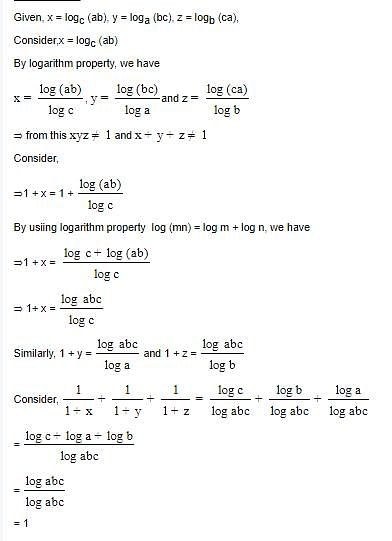
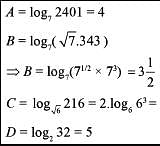
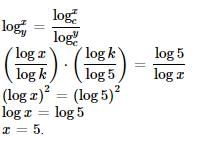
 ?
?